After a period of investigations, building permit reviews and discussions, it has now been decided that the King’s House will contain the offices of the University Management and its staff.
The aim of the renovation is to develop the King’s House and create around 40 work stations for the University Management, including a mixture of open-plan and separate offices. To meet current requirements, the renovation will also bring improvements to accessibility, fire safety and indoor climate. The long-awaited renovation is expected to be completed by the end of summer 2023.
“The King’s House is an important building for the whole experience of Lundagård and the University Square. With this news, we are one step closer to being able to fill the building with life and movement once again, and the modernisation will make this beautiful and historic building accessible to many more people”, said Lund University’s Vice-Chancellor Erik Renström.
Because the building was constructed in the 1580s, its cultural and historic value must be preserved. Among other things, some of the building’s rooms will be recreated and adapted to become a shared workspace. Certain modernisations will be added, such as a stairwell with a lift and a new entrance facing the University Square. There are currently only a couple of spiral staircases to reach certain floors in the building, while the stairwell to the south contains the famous winding oak staircase from 1731.
During preparatory work to decide on the location of the lift, the National Property Board was reminded that the building stands on ancient foundations, to say the least.
Archaeological excavations in preparation for the new lift shaft revealed floors and walls whose most ancient parts dated back to the 1000s and 1100s. The discovery required a new solution to enable the preservation of the ancient floors and walls – even if hidden from view.


